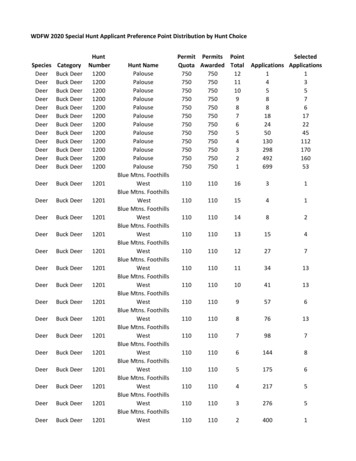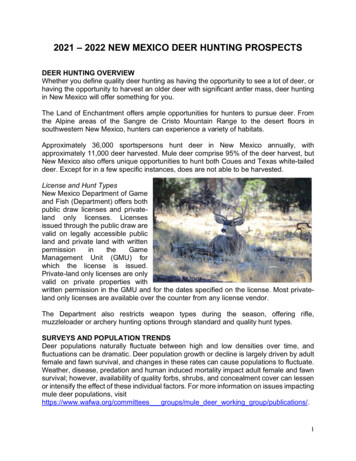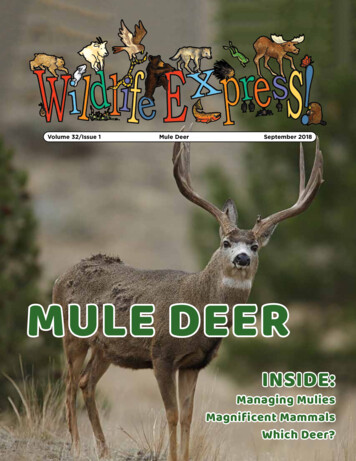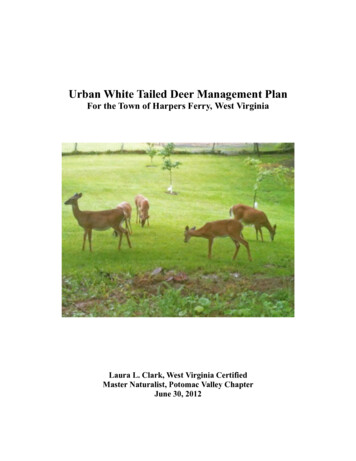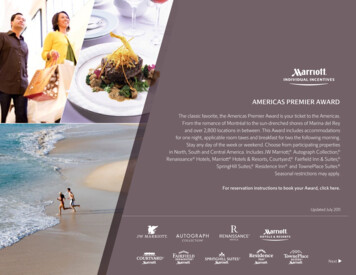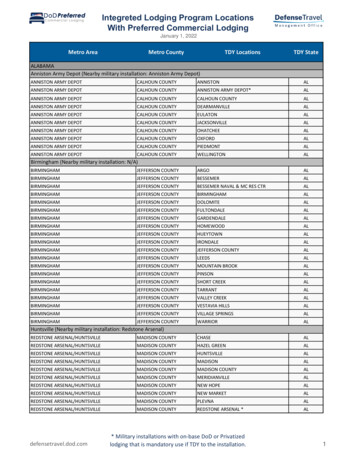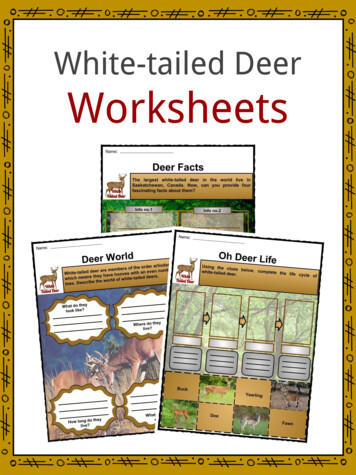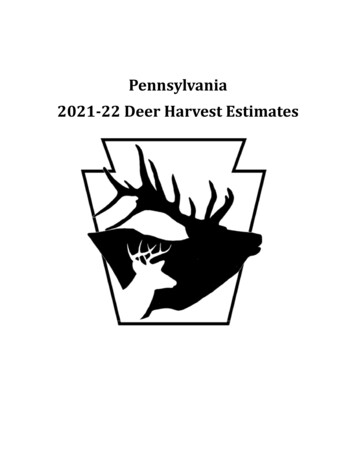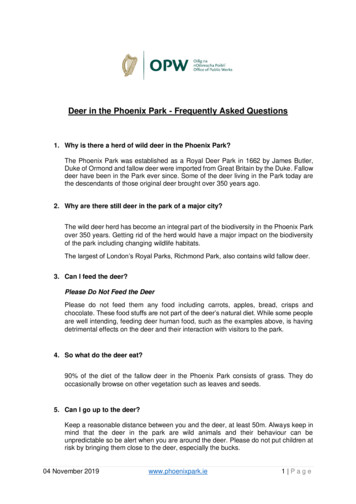
Transcription
Deer in the Phoenix Park - Frequently Asked Questions1. Why is there a herd of wild deer in the Phoenix Park?The Phoenix Park was established as a Royal Deer Park in 1662 by James Butler,Duke of Ormond and fallow deer were imported from Great Britain by the Duke. Fallowdeer have been in the Park ever since. Some of the deer living in the Park today arethe descendants of those original deer brought over 350 years ago.2. Why are there still deer in the park of a major city?The wild deer herd has become an integral part of the biodiversity in the Phoenix Parkover 350 years. Getting rid of the herd would have a major impact on the biodiversityof the park including changing wildlife habitats.The largest of London’s Royal Parks, Richmond Park, also contains wild fallow deer.3. Can I feed the deer?Please Do Not Feed the DeerPlease do not feed them any food including carrots, apples, bread, crisps andchocolate. These food stuffs are not part of the deer’s natural diet. While some peopleare well intending, feeding deer human food, such as the examples above, is havingdetrimental effects on the deer and their interaction with visitors to the park.4. So what do the deer eat?90% of the diet of the fallow deer in the Phoenix Park consists of grass. They dooccasionally browse on other vegetation such as leaves and seeds.5. Can I go up to the deer?Keep a reasonable distance between you and the deer, at least 50m. Always keep inmind that the deer in the park are wild animals and their behaviour can beunpredictable so be alert when you are around the deer. Please do not put children atrisk by bringing them close to the deer, especially the bucks.04 November 2019www.phoenixpark.ie1 Page
6. Can I take photographs/selfies with the deer?If you wish to take a photograph, keep a distance of at least 50m between you and thedeer. Please do not take selfies with the deer as they are wild animals.7. How many deer are in the Phoenix Park?Today the herd is maintained at approximately 600 wild deer.8. What size/ weight do fallow deer grow to?The weight of an adult male is 53kg – 90kg and adult female is 35kg – 55kgThey are approximately 0.9m in height and 1.6m long9. Why do each of the deer have a tag in their ear?The ear tags allow us to identify each individual deer. Tagging the deer is a vital partof their management and gives us an insight to their biology and behaviour. The colourof the tags change yearly so it is possible to age a deer by looking at the colour of itstag. On the tags there is a sequence of number that allows us to identify the deer onan individual level.10. What are the different colours of the fallow deer in the Phoenix Park?There are 4 main colour variations of fallow deer in the Phoenix Park Spots are dominant over no spotsBlack is dominant over BrownBlack Spots CommonBrown Spots Menil11. When are the new fawns born?Fawning season is in the months of June and July.12. What should I do if I come across a new born fawn?If you find a fawn, do not touch it or attempt to move it. If the mother smells your scenton her fawn she will reject it and the fawn will die.Fawns are often left hidden in long grass by their mothers. She will return every fewhours to allow the fawn to suckle (drink milk). The fawns are never abandoned.04 November 2019www.phoenixpark.ie2 Page
13. When is the rutting season?Peak mating activity occurs in mid-October/early November and is known as the Rut.During the rut a wide array of physical changes and ritual displays occur.14. Can I watch the rutting?We advise the public to stay away from the bucks during the Rut. During ruttingseason, the bucks can become aggressive due to an increase of testosterone andcompetition for mates. The bucks become very dangerous and unpredictable duringthis season. By encouraging them to approach the public they have the potential toinjury members of the public especially during rutting season.15. Why do male deer lose their antlers each year and when?Antlers initially form in cartilage and then mineralise into bone. The antlers are coveredwith a protective skin which supplies the antlers with blood to allow them to grow. Thisskin is called Velvet. In late August, the antlers are fully grown. At this point the velvetis shed. This can be a messy time as the velvet may be bloody and may take hours oreven days before it falls off. The bucks will often rub their antlers vigorously againstvegetation in order to remove the velvet. Another surge of testosterone causes theantlers to harden and maintains the dead bone once the velvet has fallen off.A drop in testosterone will cause the antlers to fall off in April or May and this is knownas casting. Sometimes the bucks will lose one antler at a time. The new antlers willstart growing soon after. Generally, the next set will be bigger than the last until thebuck reaches their prime.16. How do the OPW manage the wild deer herd?Fallow deer have no natural predators in Ireland ever since the grey wolf becameextinct in 1786. Ireland’s largest land predators are now the fox and the stoat. Whilefoxes may prey on the young fawns, neither of these predators are large enough tosuccessfully hunt the fallow deer. Therefore, there is no natural populationmanagement of fallow deer in the park. It is necessary to control the population throughculling.17. Why do the OPW undertake culls of the herd?If there is no population management the deer will overgraze and food sources willbecome scarce leading to welfare issues such as low body fat, malnutrition and highincidences of deaths from exposure during cold winters. The increase in fallow deerpopulation would also lead to a build-up of parasites and other pathogens causingdisease to spread rapidly. A lack of population control can also have a detrimentaleffect on the other flora and fauna in the park. Therefore, it is necessary to control thepopulation through culling a number of deer yearly to maintain the herd at a sustainablesize (600 deer). The cull is carried out in conjunction with the Department ofAgriculture, Food and the Marine and the School of Biology and Environmental04 November 2019www.phoenixpark.ie3 Page
Science, UCD, overseen by a qualified Vet and under license from National Parks andWildlife Services (NPWS).18. Are there any alternatives to culling and what are they?A number of alternative methods for deer population control have been suggested butall have different reasons why they are not suitable in the Phoenix Park. Administrating Contraception: There are no contraceptives licensed for use in freeliving deer in Ireland. Contraception is also difficult to monitor - which females havereceived contraception and if they are receiving a sufficient dose. There may alsobe a negative effect if the contraceptive drug is leeched into the environment oringested by males (causing adverse effects on antler growth and shedding) or byother animals. Castrating males: One male can sire many offspring therefore castrating malesmay not reduce the number of fawns being born. Relocating a number of individuals: Rounding up the deer can be a very stressfulexperience. Confining them in an enclosed space can also lead to injury or death.Transporting deer is again a very stressful experience. It is illegal in Ireland torelease any deer even if they are being relocated. Finally, moving the deer to anew location simply moves the problem elsewhere.19. How many deer are culled each year?On average 90 animals per year.20. What happens to the carcasses after each cull?The carcasses are removed by refrigerated vehicle by an authorised Game Dealerwho is approved by the Department of Agriculture, Food and the Marine.21. Does the OPW receive payment for the carcasses of the deer?The OPW does not carry out culls in order to generate profit. The OPW does receivepayment from the selling of the deer carcasses, and this is returned to the exchequer.22. Does the OPW seek advice on the management of the herd and from whom?The OPW seek advice from the School of Biology & Environmental Science atUniversity College Dublin and the Department of Agriculture, Food and Marine (DeerManagement in Ireland a Framework for Action – 2015). The OPW liaises with theRoyal Parks London, whose deer management practices are endorsed by The BritishDeer Society and the Deer Initiative of England.The OPW is also a member of the Irish Deer Society and received the John NicholsonPerpetual Trophy in 2016. The trophy is the society’s highest honour, awarded for04 November 2019www.phoenixpark.ie4 Page
meritorious service in the welfare, conservation, management and protection of deerin Ireland.23. Who do I contact if I come across an injured deer or a deer that is outside thePhoenix Park?Please contact the Park Superintendent’s office as soon as possible. The telephonenumber is: 353 1 821 3021 (8am – 5pm, Monday – Friday)Or alternatively, the Park Rangers on: 353 87 228 9688or 353 87 228 9698(Park Rangers, 6.30am – 11.30pm, seven days a week)24. What can I do to help advise the public about the dangers of feeding the deerand getting too close to them?The OPW is introducing a Deer Ambassadors’ initiative in the Park, where we will invitemembers of the public to a meeting where we outline the importance of the deer in thepark and what ambassadors can do to advise the public.25. What does the deer keeper do?The main job of the Deer Keeper is to look after the welfare of the deer herd. He alsoliaises with, and assists, the School of Biology & Environmental Science at UniversityCollege Dublin with their work in the Park. If there are any major events or concerts inthe park the Deer Keeper monitors the deer for any distress that may occur within thedeer herd. From time to time the Deer Keeper also gives talks to various schools,universities and community groups.26. What about Lyme Disease?Deer are common carriers of ticks, but there has been no evidence of Lyme Diseasein the Phoenix Park either among Park staff or members of the public. However,people should be aware of the disease, its causes, and its symptoms and should lookout for any signs. Please see the HSE website for further details on se/.27. Can I walk my dog near the deer?04 November 2019www.phoenixpark.ie5 Page
Please be mindful of your dog around the deer. Deer are a prey species and as of suchare very wary of their predators (such as wolfs) and anything that resembles theirpredators (such as dogs). Deer can feel threatened by dogs even over long distancesand when dogs are not behaving aggressively. In order to prevent any undue stresson the deer: Please keep your dogs on a lead where the deer are presentPlease keep your dog 50m or more away from the deer at all timesPlease consider walking your dog outside the park during the fawning (June/July)and rutting season (October/November)28. Is the Office of Public Works undertaking any studies on the deer at present?There are currently a number of research projects being undertaken by students fromthe School of Biology & Environmental Science at University College DublinProject 1:This project focuses on the effects of human interaction with the deer in the PhoenixPark and to understand the complex effects that these interactions may have on ourwildlife. This involves on-the-field collection of data on both male and female herds offallow deer in Phoenix Park. The deer are often fed by visitors, despite it being againstPark policy. This close-contact has led to major animal welfare and human safetyconcerns.Project 2:This project aims to understand the link between animal personality and life historytraits in wild fallow deer. Animal personality within wild deer is an important componentof behaviour, and influences resilience to external factors such as human disturbance,climate and habitat change.Project 3:A research project that uses photographs to measure antler size and shape in PhoenixPark fallow deer - the first of its kind in any deer species. This technique allows tomeasure antler size and shape from a distance of 50-250 metres without interferingwith deer behaviour.04 November 2019www.phoenixpark.ie6 Page
Deer in the Phoenix Park - Frequently Asked Questions 1. Why is there a herd of wild deer in the Phoenix Park? The Phoenix Park was established as a Royal Deer Park in 1662 by James Butler, Duke of Ormond and fallow deer were imported from Great Britain by the Duke. Fallow deer have been in the Park ever since.
